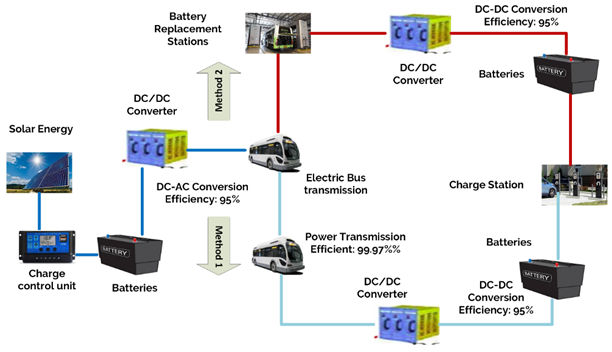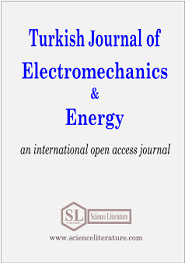
Optimization of number and spatial distribution of solar charge stations for electric buses: Case study, Bus Rapid Transit (BRT) lines
Abstract
As an energy-consuming technology, Electric Vehicles (EVs) create a demand for energy that can be met through renewable energy. In addition to the environmental benefits of this shift, electric transportation benefits from high efficiencies and expands the electrical energy storage system for renewable energy. Meanwhile, solar energy, as one of the most important sources of renewable energy that has a very high potential in Iran, can be used to power EVs. The present study provides a new approach to calculate and optimize the number and location of solar charge stations (SCSs) required for EVs in bus lines all over Tehran. This approach aims to minimize the number of charge stations while covering all bus lines and minimizing the energy loss of transmission in an Electric Vehicle Mobile Energy Network (EV-MEN). Currently, none of the bus lines in Tehran has a charging station. This paper can be a guide in future planning in this area. The results show that if the number of charging stations in Tehran equals six, all bus lines will be covered and energy losses will be minimized.
Full Text:
PDFReferences
References
M. Mohammadi, Y. Noorollahi, B. Mohammadi-ivatloo, and H. Yousefi, “Energy hub: From a model to a concept – A review,” Renewable and Sustainable Energy Reviews, vol. 80, pp. 1512–1527, December 2017.
B. Mohan and M. V. Ramesh. "Optimal DG placement under standard market design using GA," 2012 International Conference on Emerging Trends in Electrical Engineering and Energy Management, 2012, pp. 148–153.
Y. Noorollahi, A. Aligholian, A. Golshanfard, “Stochastic energy modeling with consideration of electrical vehicles and renewable energy resources-A review” Energy Management and Technology (JEMT), Vol. 4, pp. 13-26, 2017, pp. 1598-1604.
Y. Noorollahi, A. Golshanfard, A. Aligholian, B. Mohammadi-ivatloo, S. Nielsen, and A. Hajinezhad, “Sustainable Energy System Planning for an Industrial Zone by Integrating Electric Vehicles as Energy Storage,” J. Energy Storage, vol. 30, p. 101553, 2020.
S. Y. Ge, L. Feng, H, Liu, L. Wang, " The Planning of Electric Vehicle Charging Stations in the Urban Area," 2012 Proceedings of the 2nd International Conference on Electronic & Mechanical Engineering and Information Technology, 2012
J. Liu, “Electric vehicle charging infrastructure assignment and power grid impacts assessment in Beijing,” Energy Policy, vol. 51, pp. 544–557, Dec. 2012.
Y. Huang and K. M. Kockelman, “Electric vehicle charging station locations: Elastic demand, station congestion, and network equilibrium,” Transp. Res. Part D Transp. Environ., vol. 78, p. 102179, Jan. 2020.
R. Irle, "Deloitte analysis: Automotive planning solutions, IHS Markit, The electric vehicle world sales database," 2021, Online, [Available]: https://www.ev-volumes.com/, {Accessed 11 December 2021]
P. A. Østergaard, N. Duic, Y. Noorollahi, H. Mikulcic, and S. Kalogirou, “Sustainable development using renewable energy technology,” Renew. Energy, vol. 146, pp. 2430–2437, Feb. 2020.
P. A. Østergaard, N. Duic, Y. Noorollahi, and S. A. Kalogirou, “Recent advances in renewable energy technology for the energy transition,” Renew. Energy, 175(1), pp. 877–884, 2021.
S. Ge, L. Feng, and H. Liu, "The planning of electric vehicle charging station based on Grid partition method," 2011 International Conference on Electrical and Control Engineering, 2011, pp. 2726–2730.
H. Wang, Q. Huang, C. Zhang, and A. Xia, "A novel approach for the layout of electric vehicle charging station," The 2010 International Conference on Apperceiving Computing and Intelligence Analysis Proceeding, Chengdu, 2010, pp. 64–70.
G. Wang, Z. Xu, F. Wen, and K. P. Wong, “Traffic-constrained multiobjective planning of electric-vehicle charging stations,” IEEE Trans. Power Deliv., 28(4), pp. 2363–2372, 2013.
Z. A. Padhya, S. S. Bohra, “Power management analysis for V2G (Vehicle-to-Grid) applications in a microgrid with photovoltaic source," Turkish Journal of Electromechanics and Energy, Vol. 5, pp. 61-73, 2020.
M. Aziz, T. Oda, T. Mitani, Y. Watanabe, and T. Kashiwagi, “Utilization of electric vehicles and their used batteries for peak-load shifting,” Energies, 8(5), pp. 3720–3738, 2015.
M. Mohammadi, Y. Noorollahi, B. Mohammadi-ivatloo, M. Hosseinzadeh, H. Yousefi, and S. T. Khorasani, “Optimal management of energy hubs and smart energy hubs – A review,” Renew. Sustain. Energy Rev., vol. 89, pp. 33–50, Jun. 2018.
P. Parvazi, S. Mohammadi, F. Nouruzi Fard, "Intelligent BRT in Iran," Journal of Automation, Mobile Robotics & Intelligent Systems, Vol. 6, pp. 49-52, 2012.
P. A. Østergaard, N. Duic, Y. Noorollahi, H. Mikulcic, and S. Kalogirou, “Sustainable development using renewable energy technology,” Renewable Energy, vol. 146, pp. 2430–2437, Feb. 2020.
Y. Noorollahi, A. Aligholian, and A. Golshanfard, "Stochastic energy modelling with consideration of electric vehicles and renewable energy resources-A review," J. Energy Manag. Technol., 4(1), pp. 13–26, 2020.
URN: https://sloi.org/urn:sl:tjoee63194
Copyright (c) 2021 Turkish Journal of Electromechanics and Energy

This work is licensed under a Creative Commons Attribution-NonCommercial 4.0 International License.

 Indexed in:
Indexed in:















